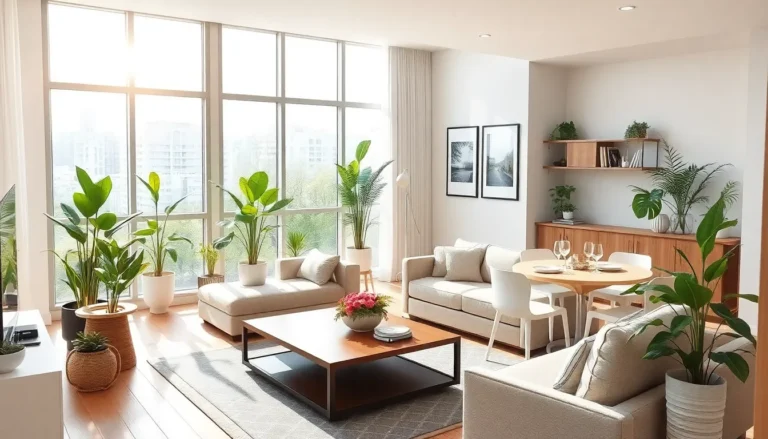Table of Contents
ToggleEver walked into a room and felt like it was giving you the cold shoulder? That’s where feng shui swoops in like a superhero, ready to rescue your space from bad vibes. It’s not just about arranging furniture; it’s about creating an environment that flows with positive energy. Who wouldn’t want their home to feel like a cozy hug instead of a chaotic tornado?
Understanding Feng Shui
Feng shui is a practice that aims to optimize the flow of energy in a space. This ancient Chinese methodology considers various elements to create a balanced and serene environment.
What Is Feng Shui?
Feng shui translates to “wind” and “water.” This discipline focuses on arranging spaces to enhance natural energy, known as chi. A well-organized environment promotes positive energy flow, influencing well-being and prosperity. Practitioners use specific principles, such as the placement of furniture and color choices, to create harmony. By understanding these elements, individuals can cultivate a peaceful atmosphere.
History and Origins of Feng Shui
Feng shui originated over 3,000 years ago in ancient China. Its roots lie in agricultural practices, as farmers sought patterns in nature to improve crop yields. The practice evolved, incorporating Taoist philosophy and geomancy. Traditional texts detail the significance of landscapes and their impacts on human life. The course of feng shui changed over centuries, adapting to various cultural contexts while maintaining its core principles. Today, it remains a vital influence in architecture and interior design worldwide.
Key Principles of Feng Shui

Feng shui principles help create a balanced and harmonious environment. Understanding these core concepts enhances the flow of energy, resulting in improved well-being.
The Bagua Map
The Bagua map serves as a guide to understanding energy distribution in a space. This octagonal grid identifies eight areas of life, including wealth, health, and relationships. By aligning the map with your floor plan, it’s possible to assess how each area affects personal well-being and interactions. Positioning elements in accordance with the Bagua can amplify positive energy in specific life aspects. Applying this map to various areas helps maintain an energetic balance, fostering a conducive environment for growth.
The Five Elements
The five elements—wood, fire, earth, metal, and water—are essential in feng shui practice. These elements represent different energies and can be combined to create harmony. Wood stimulates growth and creativity, while fire ignites passion and energy. Earth brings stability and nourishment. Metal promotes clarity and focus. Water fosters abundance and flow. Integrating these elements into spaces helps achieve equilibrium, influencing both the environment and emotions positively. Each element interacts uniquely, hence balancing them ensures a vibrant atmosphere conducive to personal and communal thriving.
Practical Feng Shui Tips for Home
Feng shui enhances home environments by optimizing energy flow. Practical tips can easily create a more harmonious living space.
Enhancing Living Spaces
Maximize natural light by opening curtains and positioning mirrors to reflect energy. Arrange furniture in a way that promotes conversation and connection, avoiding blockages in pathways. Incorporate plants to introduce vibrant energy and improve air quality. Choose colors that resonate with positive emotions, such as soft greens or warm earth tones. Maintain cleanliness by regularly decluttering, allowing energy to move freely throughout the space.
Bedroom Feng Shui Tips
Position the bed in a commanding location, ideally facing the door but not directly in line with it. Select calming colors, like blues or soft whites, promoting relaxation and tranquility. Use nightstands on both sides for balance and create a supportive atmosphere. Avoid electronics like TVs and computers in the bedroom, minimizing distractions. Keep under-bed areas clear to allow for restful sleep and promote positive energy.
Kitchen Feng Shui Tips
Place the stove in a visible position from the entrance for a sense of control while cooking. Prioritize cleanliness by regularly tidying countertops and organizing appliances. Incorporate a mix of colors, particularly reds and yellows, inviting warmth and abundance. Use natural materials like wood to enhance grounding energy and connect with nature. Maintain a balanced flow of energy by ensuring cupboards and drawers open smoothly, facilitating easy access and organization.
Feng Shui Tips for Workspaces
Feng shui principles enhance energy flow within workspaces. Implementing these practices promotes productivity and well-being.
Creating a Productive Environment
Natural light significantly improves mood and energy levels. Position desks near windows to maximize sunlight exposure. Incorporating plants boosts creativity while purifying the air. Adding personal items, like photos or mementos, fosters a sense of connection and comfort. Utilizing calming colors, such as blue or green, creates a serene atmosphere that minimizes stress. Maintaining a clutter-free space enhances focus and allows energy to circulate freely. Choosing artwork that inspires positivity adds an uplifting touch to the environment. Adjusting the workspace design based on individual preferences ensures optimal comfort and efficacy.
Organizing Your Desk
Keeping a tidy desk enhances clarity and focus. Utilize organizers to separate essential items, reducing visual clutter. Position frequently used tools within arm’s reach to streamline workflow. Avoid overloading the workspace with unnecessary objects to maintain clarity. Choosing a comfortable chair supports good posture and prevents fatigue. Placing the computer screen at eye level reduces strain and improves concentration. Using neutral or bright colors for office supplies can evoke a sense of vibrancy. Customizing the desk layout to fit personal workflow patterns enhances efficiency and satisfaction.
Feng Shui Tips for Outdoors
Feng shui principles apply to outdoor spaces, helping to create harmony and balance. Effectively arranging outdoor areas enhances positive energy.
Garden Arrangement
Arranging a garden thoughtfully can improve the flow of energy. Positioning plants in groups enhances visual appeal and encourages vitality. Incorporating a variety of plant sizes creates layers, promoting depth and movement throughout the space. Selecting vibrant flowers infuses energy while soothing greenery fosters a calming atmosphere. Pathways should remain clear and unobstructed to invite exploration and ease of movement.
Outdoor Spaces and Energy Flow
Outdoor spaces serve as extensions of living areas, impacting overall well-being. Ensuring open spaces without clutter allows for uninterrupted energy movement. Water features, like small fountains or ponds, attract positive energy and enhance tranquility. Incorporating seating areas positioned to enjoy views encourages relaxation and social interaction. Elemental balance, represented through plants, stones, and water, creates a tranquil environment.
Embracing feng shui can significantly transform living and working environments. By understanding and applying its principles, individuals can create spaces that promote positive energy and enhance overall well-being. Whether it’s through strategic furniture placement or incorporating natural elements, these practices foster harmony and balance.
The journey into feng shui isn’t just about aesthetics; it’s about cultivating an atmosphere that nurtures comfort and tranquility. As one integrates these tips into their home and workspace, they’ll likely notice improvements in mood and productivity. Ultimately, feng shui serves as a powerful tool for enhancing life quality, inviting positive energy to flow freely throughout every space.







